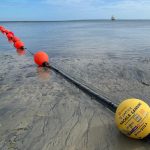Scientists Stuff 661Tbps Down a Single Optic Fibre at High Efficiency
A team of scientists from Japan and the EU have found a way to replace the use of many parallel lasers with a single frequency comb source, which has enabled them to push data at a speed of 661Tbps (Terabits per second) down a single-mode 30 core optical fibre cable.
Funnily enough the interesting development here isn’t that headline figure of 661Tbps, which has already been beaten by NTT’s transmission rate of 1.05Pbps via a similar multi-core single fibre (using fewer WDM channels and a greater per-channel bandwidth). Instead the focus is on some significant improvements in the underlying laser technology.
The problem is that lasers aren’t the most energy efficient bits of kit in the world (the best ones tend to be 30-50% efficient) and to push more data down an optical fibre cable you often need to stick on a bunch of them (i.e. all running in parallel with each colour requiring its own laser, which is where the usual Wavelength Division Multiplexing has its fun).
Advertisement
Suffice to say that power becomes a growing problem as you increase network capacity, not least by adding more lasers. According to the research team, the internet today transmits hundreds of Terabits per second, consumes 9% of all electricity worldwide and grows by 20-30% per year.
The solution they’ve come up with is to create a single frequency comb source that sends out pulses of light stacked with very pure colours, which are then separated via gaps in frequency (i.e. you don’t need all those individual lasers running in parallel anymore).
Researcher Hao Hu said:
We present a frequency comb realized by a non-resonant aluminium-gallium-arsenide-on-insulator (AlGaAsOI) nanowaveguide with 66% pump-to-comb conversion efficiency, which is significantly higher than state-of-the-art resonant comb sources. This enables unprecedented high data-rate transmission for chip-based sources, demonstrated using a single-mode 30-core fibre.
We show that our frequency comb can carry 661 Tbit s–1 of data, equivalent to more than the total Internet traffic today. The comb is obtained by seeding the AlGaAsOI chip with 10-GHz picosecond pulses at a low pump power (85 mW), and this scheme is robust to temperature changes, is energy efficient and facilitates future integration with on-chip lasers or amplifiers
The related research paper can be found online and Arstechnica also has a good write-up on the many clever changes and tricks that have gone into making this all work. The focus here is largely on high-capacity data links rather than consumer connectivity, although developments like this will all eventually feed into the same network ecosystem.
The work itself was funded by the Silicon Photonics for Optical Communications (SPOC) research centre of excellence (DNRF123), the Nanophotonics for Terabit Communications (NATEC) Villum centre of excellence and the European Union–Japan coordinated R&D project on Scalable And Flexible optical Architecture for Reconfigurable Infrastructure (SAFARI).
Advertisement
Mark is a professional technology writer, IT consultant and computer engineer from Dorset (England), he also founded ISPreview in 1999 and enjoys analysing the latest telecoms and broadband developments. Find me on X (Twitter), Mastodon, Facebook, BlueSky, Threads.net and Linkedin.
« £250m Raised to Fund Hyperoptic 1Gbps FTTP for 2 Million UK Premises
















































Comments are closed